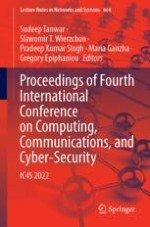2023 | OriginalPaper | Buchkapitel
AutoBots: A Botnet Intrusion Detection Scheme Using Deep Autoencoders
verfasst von : Ashwin Verma, Pronaya Bhattacharya, Vivek Kumar Prasad, Rajan Datt, Sudeep Tanwar
Erschienen in: Proceedings of Fourth International Conference on Computing, Communications, and Cyber-Security
Verlag: Springer Nature Singapore
Aktivieren Sie unsere intelligente Suche, um passende Fachinhalte oder Patente zu finden.
Wählen Sie Textabschnitte aus um mit Künstlicher Intelligenz passenden Patente zu finden. powered by
Markieren Sie Textabschnitte, um KI-gestützt weitere passende Inhalte zu finden. powered by
